Marketing Strategy for Kathmandu Ltd - NZ Diploma in Business (2930)
VerifiedAdded on 2023/06/11
|32
|7868
|147
Report
AI Summary
This report provides a comprehensive marketing strategy for Kathmandu Ltd, focusing on achieving international recognition and brand reputation. It includes an analysis of the target market, situational analysis of current market performance, and evaluation of the external macro-environment. The report identifies strategic options, aligns marketing objectives with strategic goals, and outlines marketing and positioning strategies, including the strategic marketing mix (4Ps). Furthermore, it presents sales forecasts, resource requirements, and performance evaluation mechanisms, concluding with recommendations for corrective actions to address identified gaps in the marketing plan. The primary goal is to maximize customer engagement and improve the company's market share through effective marketing activities and promotional strategies.

Course qualification NZ Diploma in Business and Enterprise Management (Level 7)
US/Prescription title: Marketing strategy
Course/Paper number: 2930
Student name: Jinho Song
Student ID: 174482A
Teacher: Tim, Neetu
Assessment type: 2nd assignment
Due date: 22/Aug/2018
Student(s) to complete: Assignment/Report Plagiarism Declaration
For Individual Assignment / Report ONLY
I certify that this is my own work and I have read and understood
the Plagiarism and Dishonest Policy (7.7) of Abacus Institute of
Studies.
I understand that the submission of this form electronically is the
equivalent of me signing my name, in pen, on a paper assignment
cover sheet.
For Group assignments/reports ONLY:
Student name(s) & IDs:
1.
2.
3.
Campuses
Auckland
Level 5 / 3 Wakefield Street
Auckland
New Zealand - 1010
0064-9213-9552
Christchurch
9A/166 Moorhouse Ave
Christchurch
New Zealand - 8011
0064-3365-6076
US/Prescription title: Marketing strategy
Course/Paper number: 2930
Student name: Jinho Song
Student ID: 174482A
Teacher: Tim, Neetu
Assessment type: 2nd assignment
Due date: 22/Aug/2018
Student(s) to complete: Assignment/Report Plagiarism Declaration
For Individual Assignment / Report ONLY
I certify that this is my own work and I have read and understood
the Plagiarism and Dishonest Policy (7.7) of Abacus Institute of
Studies.
I understand that the submission of this form electronically is the
equivalent of me signing my name, in pen, on a paper assignment
cover sheet.
For Group assignments/reports ONLY:
Student name(s) & IDs:
1.
2.
3.
Campuses
Auckland
Level 5 / 3 Wakefield Street
Auckland
New Zealand - 1010
0064-9213-9552
Christchurch
9A/166 Moorhouse Ave
Christchurch
New Zealand - 8011
0064-3365-6076
Paraphrase This Document
Need a fresh take? Get an instant paraphrase of this document with our AI Paraphraser
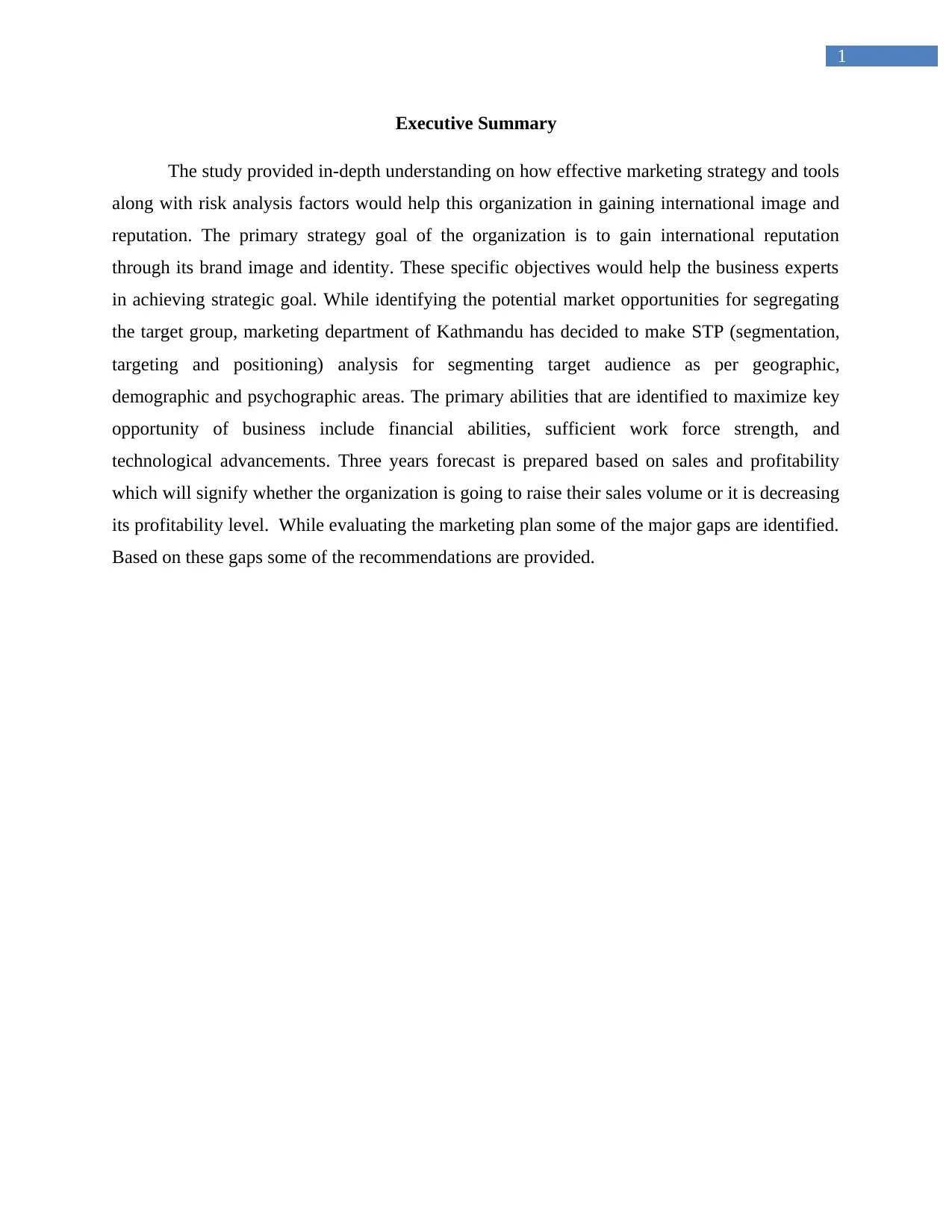
1
Executive Summary
The study provided in-depth understanding on how effective marketing strategy and tools
along with risk analysis factors would help this organization in gaining international image and
reputation. The primary strategy goal of the organization is to gain international reputation
through its brand image and identity. These specific objectives would help the business experts
in achieving strategic goal. While identifying the potential market opportunities for segregating
the target group, marketing department of Kathmandu has decided to make STP (segmentation,
targeting and positioning) analysis for segmenting target audience as per geographic,
demographic and psychographic areas. The primary abilities that are identified to maximize key
opportunity of business include financial abilities, sufficient work force strength, and
technological advancements. Three years forecast is prepared based on sales and profitability
which will signify whether the organization is going to raise their sales volume or it is decreasing
its profitability level. While evaluating the marketing plan some of the major gaps are identified.
Based on these gaps some of the recommendations are provided.
Executive Summary
The study provided in-depth understanding on how effective marketing strategy and tools
along with risk analysis factors would help this organization in gaining international image and
reputation. The primary strategy goal of the organization is to gain international reputation
through its brand image and identity. These specific objectives would help the business experts
in achieving strategic goal. While identifying the potential market opportunities for segregating
the target group, marketing department of Kathmandu has decided to make STP (segmentation,
targeting and positioning) analysis for segmenting target audience as per geographic,
demographic and psychographic areas. The primary abilities that are identified to maximize key
opportunity of business include financial abilities, sufficient work force strength, and
technological advancements. Three years forecast is prepared based on sales and profitability
which will signify whether the organization is going to raise their sales volume or it is decreasing
its profitability level. While evaluating the marketing plan some of the major gaps are identified.
Based on these gaps some of the recommendations are provided.
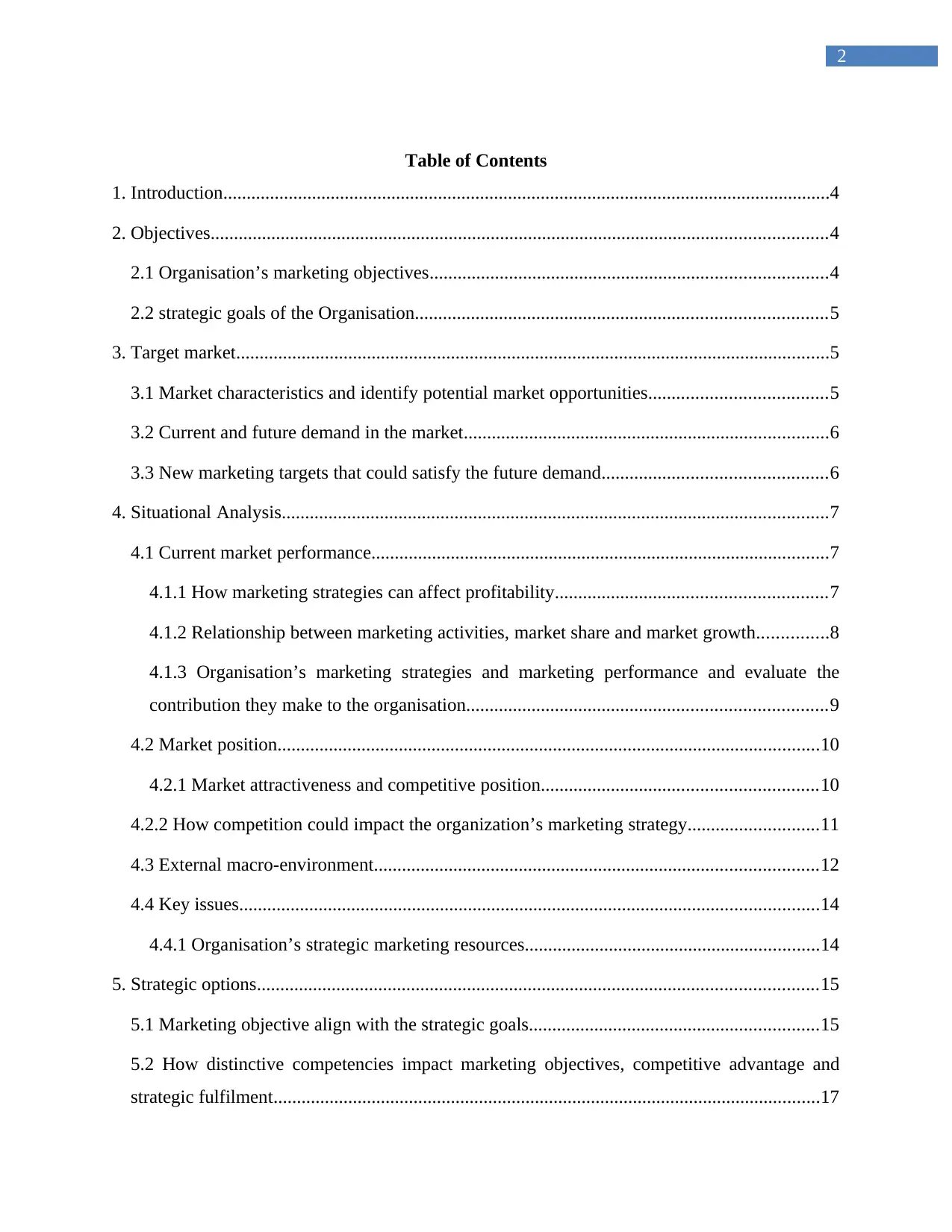
2
Table of Contents
1. Introduction..................................................................................................................................4
2. Objectives....................................................................................................................................4
2.1 Organisation’s marketing objectives.....................................................................................4
2.2 strategic goals of the Organisation........................................................................................5
3. Target market...............................................................................................................................5
3.1 Market characteristics and identify potential market opportunities......................................5
3.2 Current and future demand in the market..............................................................................6
3.3 New marketing targets that could satisfy the future demand................................................6
4. Situational Analysis.....................................................................................................................7
4.1 Current market performance..................................................................................................7
4.1.1 How marketing strategies can affect profitability..........................................................7
4.1.2 Relationship between marketing activities, market share and market growth...............8
4.1.3 Organisation’s marketing strategies and marketing performance and evaluate the
contribution they make to the organisation.............................................................................9
4.2 Market position....................................................................................................................10
4.2.1 Market attractiveness and competitive position...........................................................10
4.2.2 How competition could impact the organization’s marketing strategy............................11
4.3 External macro-environment...............................................................................................12
4.4 Key issues............................................................................................................................14
4.4.1 Organisation’s strategic marketing resources...............................................................14
5. Strategic options........................................................................................................................15
5.1 Marketing objective align with the strategic goals..............................................................15
5.2 How distinctive competencies impact marketing objectives, competitive advantage and
strategic fulfilment.....................................................................................................................17
Table of Contents
1. Introduction..................................................................................................................................4
2. Objectives....................................................................................................................................4
2.1 Organisation’s marketing objectives.....................................................................................4
2.2 strategic goals of the Organisation........................................................................................5
3. Target market...............................................................................................................................5
3.1 Market characteristics and identify potential market opportunities......................................5
3.2 Current and future demand in the market..............................................................................6
3.3 New marketing targets that could satisfy the future demand................................................6
4. Situational Analysis.....................................................................................................................7
4.1 Current market performance..................................................................................................7
4.1.1 How marketing strategies can affect profitability..........................................................7
4.1.2 Relationship between marketing activities, market share and market growth...............8
4.1.3 Organisation’s marketing strategies and marketing performance and evaluate the
contribution they make to the organisation.............................................................................9
4.2 Market position....................................................................................................................10
4.2.1 Market attractiveness and competitive position...........................................................10
4.2.2 How competition could impact the organization’s marketing strategy............................11
4.3 External macro-environment...............................................................................................12
4.4 Key issues............................................................................................................................14
4.4.1 Organisation’s strategic marketing resources...............................................................14
5. Strategic options........................................................................................................................15
5.1 Marketing objective align with the strategic goals..............................................................15
5.2 How distinctive competencies impact marketing objectives, competitive advantage and
strategic fulfilment.....................................................................................................................17
⊘ This is a preview!⊘
Do you want full access?
Subscribe today to unlock all pages.

Trusted by 1+ million students worldwide
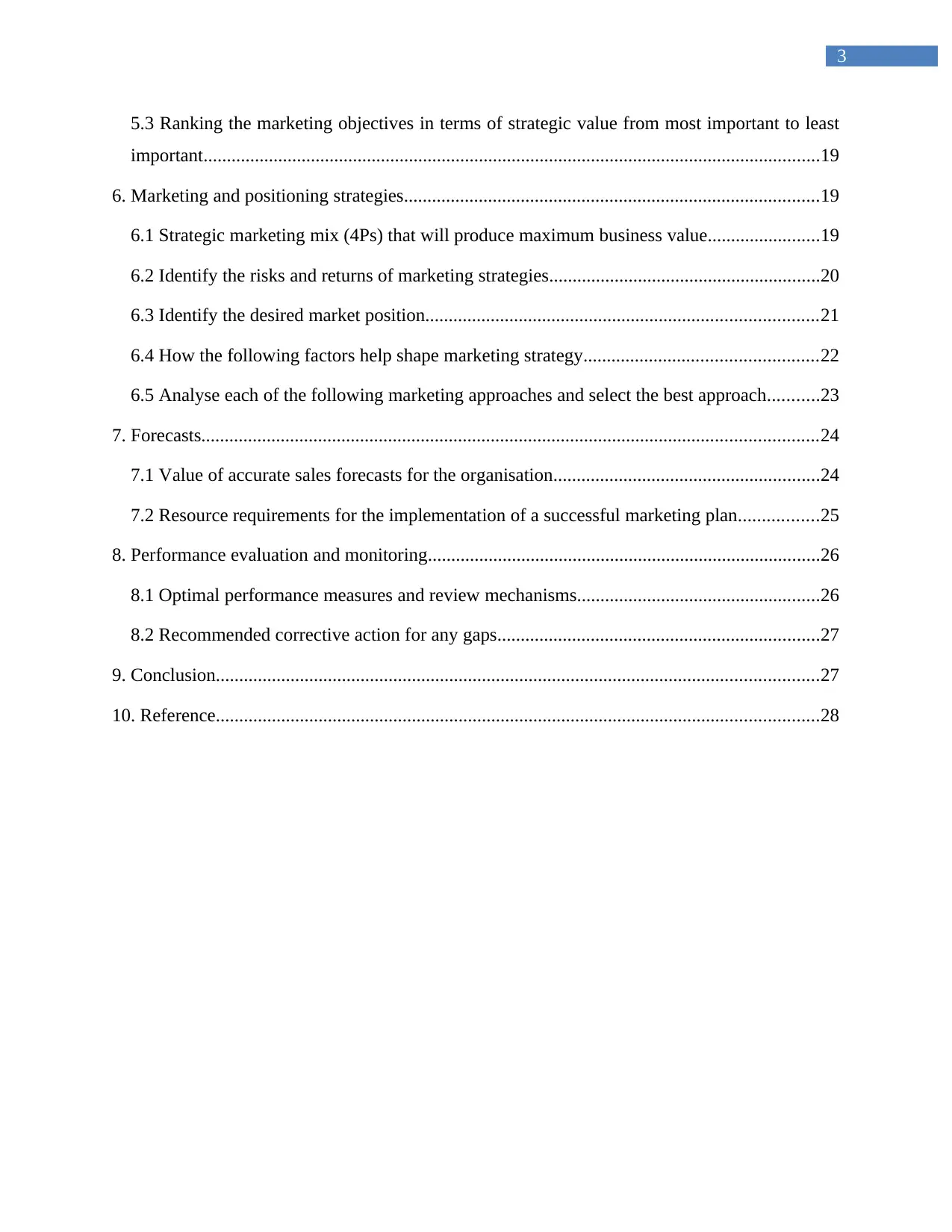
3
5.3 Ranking the marketing objectives in terms of strategic value from most important to least
important....................................................................................................................................19
6. Marketing and positioning strategies.........................................................................................19
6.1 Strategic marketing mix (4Ps) that will produce maximum business value........................19
6.2 Identify the risks and returns of marketing strategies..........................................................20
6.3 Identify the desired market position....................................................................................21
6.4 How the following factors help shape marketing strategy..................................................22
6.5 Analyse each of the following marketing approaches and select the best approach...........23
7. Forecasts....................................................................................................................................24
7.1 Value of accurate sales forecasts for the organisation.........................................................24
7.2 Resource requirements for the implementation of a successful marketing plan.................25
8. Performance evaluation and monitoring....................................................................................26
8.1 Optimal performance measures and review mechanisms....................................................26
8.2 Recommended corrective action for any gaps.....................................................................27
9. Conclusion.................................................................................................................................27
10. Reference.................................................................................................................................28
5.3 Ranking the marketing objectives in terms of strategic value from most important to least
important....................................................................................................................................19
6. Marketing and positioning strategies.........................................................................................19
6.1 Strategic marketing mix (4Ps) that will produce maximum business value........................19
6.2 Identify the risks and returns of marketing strategies..........................................................20
6.3 Identify the desired market position....................................................................................21
6.4 How the following factors help shape marketing strategy..................................................22
6.5 Analyse each of the following marketing approaches and select the best approach...........23
7. Forecasts....................................................................................................................................24
7.1 Value of accurate sales forecasts for the organisation.........................................................24
7.2 Resource requirements for the implementation of a successful marketing plan.................25
8. Performance evaluation and monitoring....................................................................................26
8.1 Optimal performance measures and review mechanisms....................................................26
8.2 Recommended corrective action for any gaps.....................................................................27
9. Conclusion.................................................................................................................................27
10. Reference.................................................................................................................................28
Paraphrase This Document
Need a fresh take? Get an instant paraphrase of this document with our AI Paraphraser

4
1. Introduction
Kathmandu Ltd is one of the most recognizable online outdoor camping stores especially
famous for its travel and outdoor apparel and equipment. Headquarter in Christchurch, New
Zealand this clothing store has occupied prestigious places of New Zealand currently by
launching 47 stores in its market. Apart from New Zealand, Kathmandu stores are also available
in the market of Australia as well. This particular company is constituted with around 2000
employees having NZ$445.35 million revenue per year. In quest of expanding this business all
overall the World, the business experts have concentrated to change their market strategy and
policy. In this regard, the Kathmandu Ltd has set its mission by stating that “we design, we test,
we adapt” (Products, 2018). It means the Company is firmly put emphasis on its innovation and
ready to change the products with the growing shift in the global customers. In addition to this,
the vision statement of the Company is coupled with the idea of expanding business all over the
world with maximizing the customer satisfaction. In fact, Kathmandu Ltd is highly relying on its
innovation and creative products that facilitate sustainability in the business operation. By using
effective promotional tools the business experts of Kathmandu aims to introduce their travel
apparel in the mind of global customers. By highlighting the primary mission and vision of this
organisation, the study has provided in-depth understanding on how effective marketing strategy
and tools along with risk analysis factors would help this organisation in gaining international
image and reputation.
2. Objectives
2.1 Organisation’s marketing objectives
Specific To maximise 2% of customers both domestically and
internationally by one year
Measurable To render product diversity in order to increase the brand
value within one year (Piercy, 2014)
Achievable To gain global recognition by increasing promotional
method within one year
Realistic To improve the skills and competency of marketing
1. Introduction
Kathmandu Ltd is one of the most recognizable online outdoor camping stores especially
famous for its travel and outdoor apparel and equipment. Headquarter in Christchurch, New
Zealand this clothing store has occupied prestigious places of New Zealand currently by
launching 47 stores in its market. Apart from New Zealand, Kathmandu stores are also available
in the market of Australia as well. This particular company is constituted with around 2000
employees having NZ$445.35 million revenue per year. In quest of expanding this business all
overall the World, the business experts have concentrated to change their market strategy and
policy. In this regard, the Kathmandu Ltd has set its mission by stating that “we design, we test,
we adapt” (Products, 2018). It means the Company is firmly put emphasis on its innovation and
ready to change the products with the growing shift in the global customers. In addition to this,
the vision statement of the Company is coupled with the idea of expanding business all over the
world with maximizing the customer satisfaction. In fact, Kathmandu Ltd is highly relying on its
innovation and creative products that facilitate sustainability in the business operation. By using
effective promotional tools the business experts of Kathmandu aims to introduce their travel
apparel in the mind of global customers. By highlighting the primary mission and vision of this
organisation, the study has provided in-depth understanding on how effective marketing strategy
and tools along with risk analysis factors would help this organisation in gaining international
image and reputation.
2. Objectives
2.1 Organisation’s marketing objectives
Specific To maximise 2% of customers both domestically and
internationally by one year
Measurable To render product diversity in order to increase the brand
value within one year (Piercy, 2014)
Achievable To gain global recognition by increasing promotional
method within one year
Realistic To improve the skills and competency of marketing
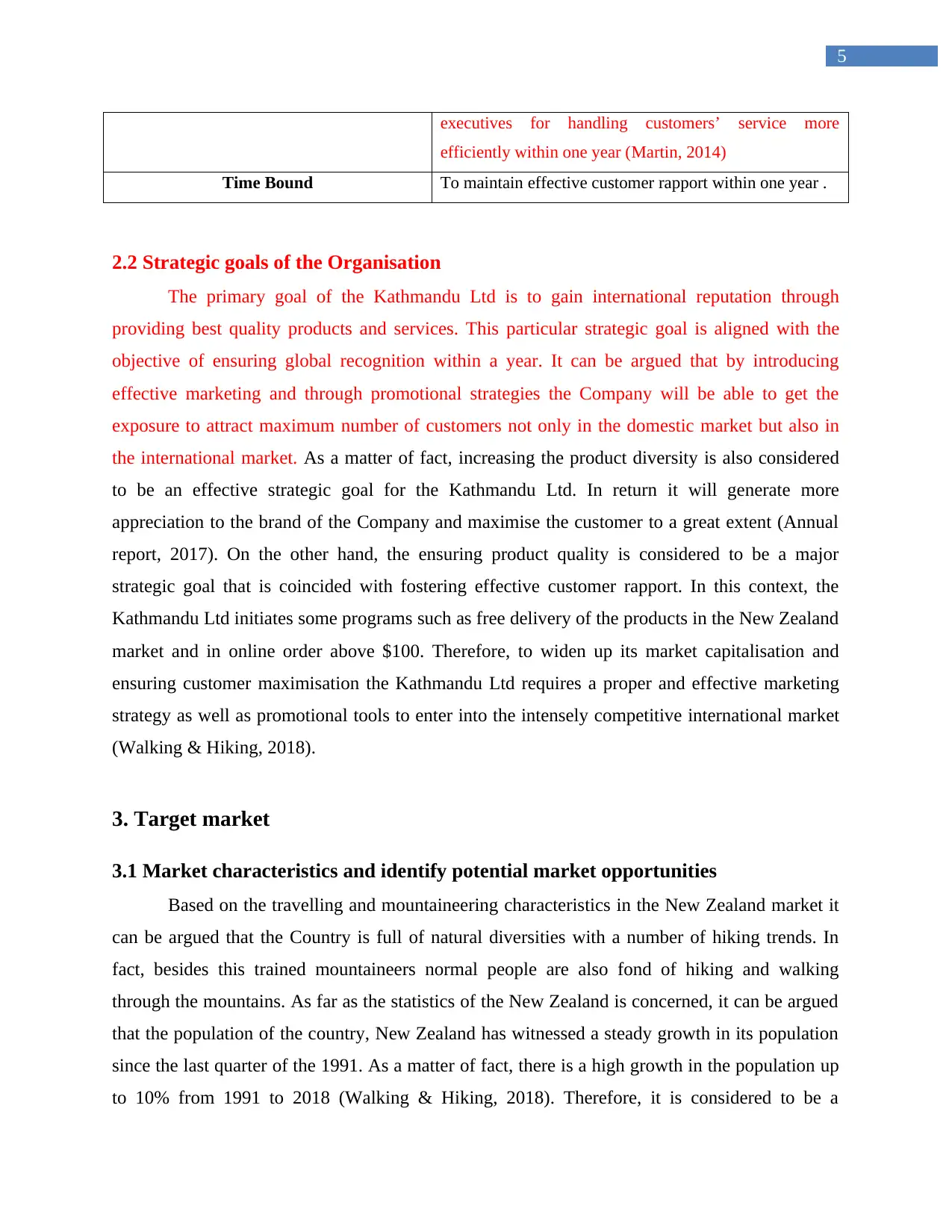
5
executives for handling customers’ service more
efficiently within one year (Martin, 2014)
Time Bound To maintain effective customer rapport within one year .
2.2 Strategic goals of the Organisation
The primary goal of the Kathmandu Ltd is to gain international reputation through
providing best quality products and services. This particular strategic goal is aligned with the
objective of ensuring global recognition within a year. It can be argued that by introducing
effective marketing and through promotional strategies the Company will be able to get the
exposure to attract maximum number of customers not only in the domestic market but also in
the international market. As a matter of fact, increasing the product diversity is also considered
to be an effective strategic goal for the Kathmandu Ltd. In return it will generate more
appreciation to the brand of the Company and maximise the customer to a great extent (Annual
report, 2017). On the other hand, the ensuring product quality is considered to be a major
strategic goal that is coincided with fostering effective customer rapport. In this context, the
Kathmandu Ltd initiates some programs such as free delivery of the products in the New Zealand
market and in online order above $100. Therefore, to widen up its market capitalisation and
ensuring customer maximisation the Kathmandu Ltd requires a proper and effective marketing
strategy as well as promotional tools to enter into the intensely competitive international market
(Walking & Hiking, 2018).
3. Target market
3.1 Market characteristics and identify potential market opportunities
Based on the travelling and mountaineering characteristics in the New Zealand market it
can be argued that the Country is full of natural diversities with a number of hiking trends. In
fact, besides this trained mountaineers normal people are also fond of hiking and walking
through the mountains. As far as the statistics of the New Zealand is concerned, it can be argued
that the population of the country, New Zealand has witnessed a steady growth in its population
since the last quarter of the 1991. As a matter of fact, there is a high growth in the population up
to 10% from 1991 to 2018 (Walking & Hiking, 2018). Therefore, it is considered to be a
executives for handling customers’ service more
efficiently within one year (Martin, 2014)
Time Bound To maintain effective customer rapport within one year .
2.2 Strategic goals of the Organisation
The primary goal of the Kathmandu Ltd is to gain international reputation through
providing best quality products and services. This particular strategic goal is aligned with the
objective of ensuring global recognition within a year. It can be argued that by introducing
effective marketing and through promotional strategies the Company will be able to get the
exposure to attract maximum number of customers not only in the domestic market but also in
the international market. As a matter of fact, increasing the product diversity is also considered
to be an effective strategic goal for the Kathmandu Ltd. In return it will generate more
appreciation to the brand of the Company and maximise the customer to a great extent (Annual
report, 2017). On the other hand, the ensuring product quality is considered to be a major
strategic goal that is coincided with fostering effective customer rapport. In this context, the
Kathmandu Ltd initiates some programs such as free delivery of the products in the New Zealand
market and in online order above $100. Therefore, to widen up its market capitalisation and
ensuring customer maximisation the Kathmandu Ltd requires a proper and effective marketing
strategy as well as promotional tools to enter into the intensely competitive international market
(Walking & Hiking, 2018).
3. Target market
3.1 Market characteristics and identify potential market opportunities
Based on the travelling and mountaineering characteristics in the New Zealand market it
can be argued that the Country is full of natural diversities with a number of hiking trends. In
fact, besides this trained mountaineers normal people are also fond of hiking and walking
through the mountains. As far as the statistics of the New Zealand is concerned, it can be argued
that the population of the country, New Zealand has witnessed a steady growth in its population
since the last quarter of the 1991. As a matter of fact, there is a high growth in the population up
to 10% from 1991 to 2018 (Walking & Hiking, 2018). Therefore, it is considered to be a
⊘ This is a preview!⊘
Do you want full access?
Subscribe today to unlock all pages.

Trusted by 1+ million students worldwide
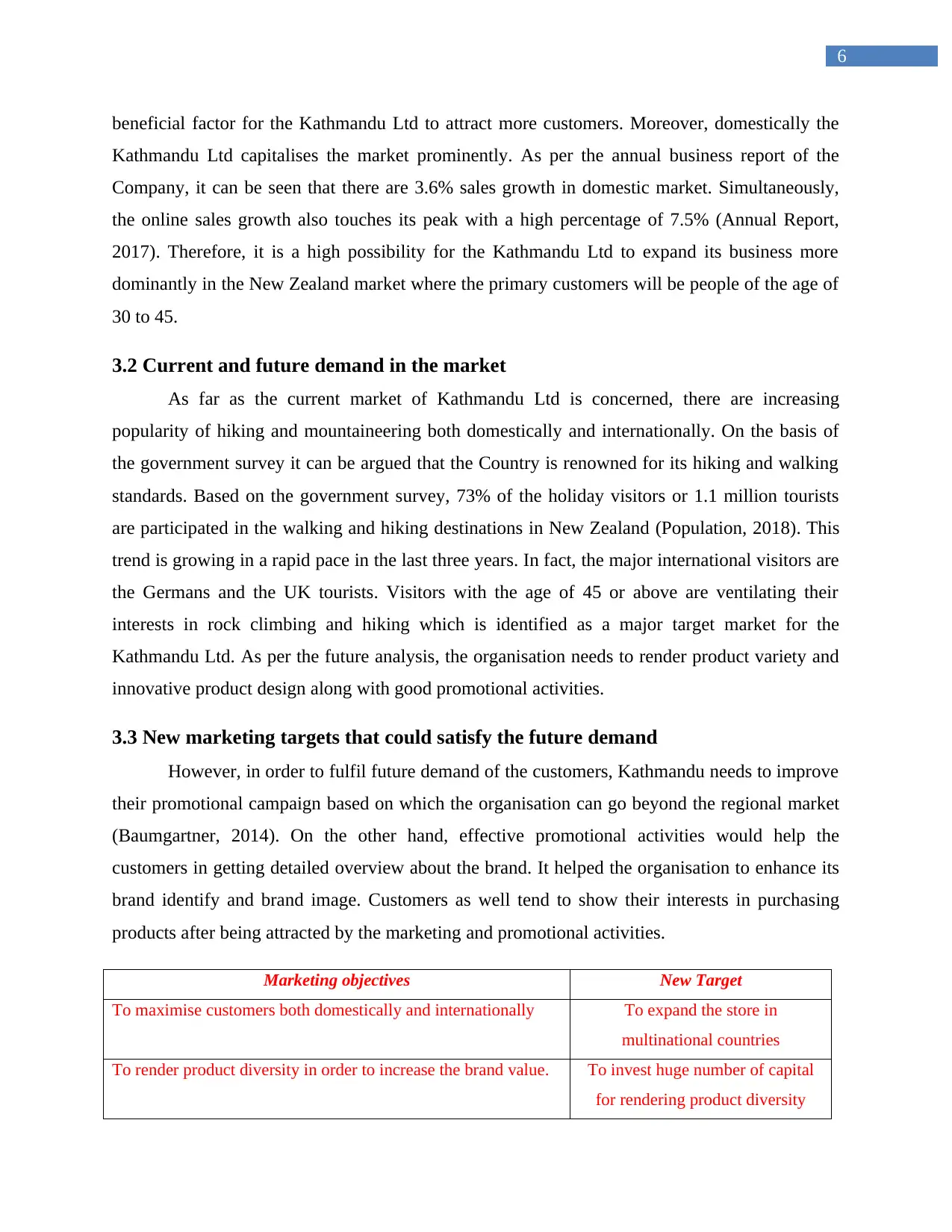
6
beneficial factor for the Kathmandu Ltd to attract more customers. Moreover, domestically the
Kathmandu Ltd capitalises the market prominently. As per the annual business report of the
Company, it can be seen that there are 3.6% sales growth in domestic market. Simultaneously,
the online sales growth also touches its peak with a high percentage of 7.5% (Annual Report,
2017). Therefore, it is a high possibility for the Kathmandu Ltd to expand its business more
dominantly in the New Zealand market where the primary customers will be people of the age of
30 to 45.
3.2 Current and future demand in the market
As far as the current market of Kathmandu Ltd is concerned, there are increasing
popularity of hiking and mountaineering both domestically and internationally. On the basis of
the government survey it can be argued that the Country is renowned for its hiking and walking
standards. Based on the government survey, 73% of the holiday visitors or 1.1 million tourists
are participated in the walking and hiking destinations in New Zealand (Population, 2018). This
trend is growing in a rapid pace in the last three years. In fact, the major international visitors are
the Germans and the UK tourists. Visitors with the age of 45 or above are ventilating their
interests in rock climbing and hiking which is identified as a major target market for the
Kathmandu Ltd. As per the future analysis, the organisation needs to render product variety and
innovative product design along with good promotional activities.
3.3 New marketing targets that could satisfy the future demand
However, in order to fulfil future demand of the customers, Kathmandu needs to improve
their promotional campaign based on which the organisation can go beyond the regional market
(Baumgartner, 2014). On the other hand, effective promotional activities would help the
customers in getting detailed overview about the brand. It helped the organisation to enhance its
brand identify and brand image. Customers as well tend to show their interests in purchasing
products after being attracted by the marketing and promotional activities.
Marketing objectives New Target
To maximise customers both domestically and internationally To expand the store in
multinational countries
To render product diversity in order to increase the brand value. To invest huge number of capital
for rendering product diversity
beneficial factor for the Kathmandu Ltd to attract more customers. Moreover, domestically the
Kathmandu Ltd capitalises the market prominently. As per the annual business report of the
Company, it can be seen that there are 3.6% sales growth in domestic market. Simultaneously,
the online sales growth also touches its peak with a high percentage of 7.5% (Annual Report,
2017). Therefore, it is a high possibility for the Kathmandu Ltd to expand its business more
dominantly in the New Zealand market where the primary customers will be people of the age of
30 to 45.
3.2 Current and future demand in the market
As far as the current market of Kathmandu Ltd is concerned, there are increasing
popularity of hiking and mountaineering both domestically and internationally. On the basis of
the government survey it can be argued that the Country is renowned for its hiking and walking
standards. Based on the government survey, 73% of the holiday visitors or 1.1 million tourists
are participated in the walking and hiking destinations in New Zealand (Population, 2018). This
trend is growing in a rapid pace in the last three years. In fact, the major international visitors are
the Germans and the UK tourists. Visitors with the age of 45 or above are ventilating their
interests in rock climbing and hiking which is identified as a major target market for the
Kathmandu Ltd. As per the future analysis, the organisation needs to render product variety and
innovative product design along with good promotional activities.
3.3 New marketing targets that could satisfy the future demand
However, in order to fulfil future demand of the customers, Kathmandu needs to improve
their promotional campaign based on which the organisation can go beyond the regional market
(Baumgartner, 2014). On the other hand, effective promotional activities would help the
customers in getting detailed overview about the brand. It helped the organisation to enhance its
brand identify and brand image. Customers as well tend to show their interests in purchasing
products after being attracted by the marketing and promotional activities.
Marketing objectives New Target
To maximise customers both domestically and internationally To expand the store in
multinational countries
To render product diversity in order to increase the brand value. To invest huge number of capital
for rendering product diversity
Paraphrase This Document
Need a fresh take? Get an instant paraphrase of this document with our AI Paraphraser
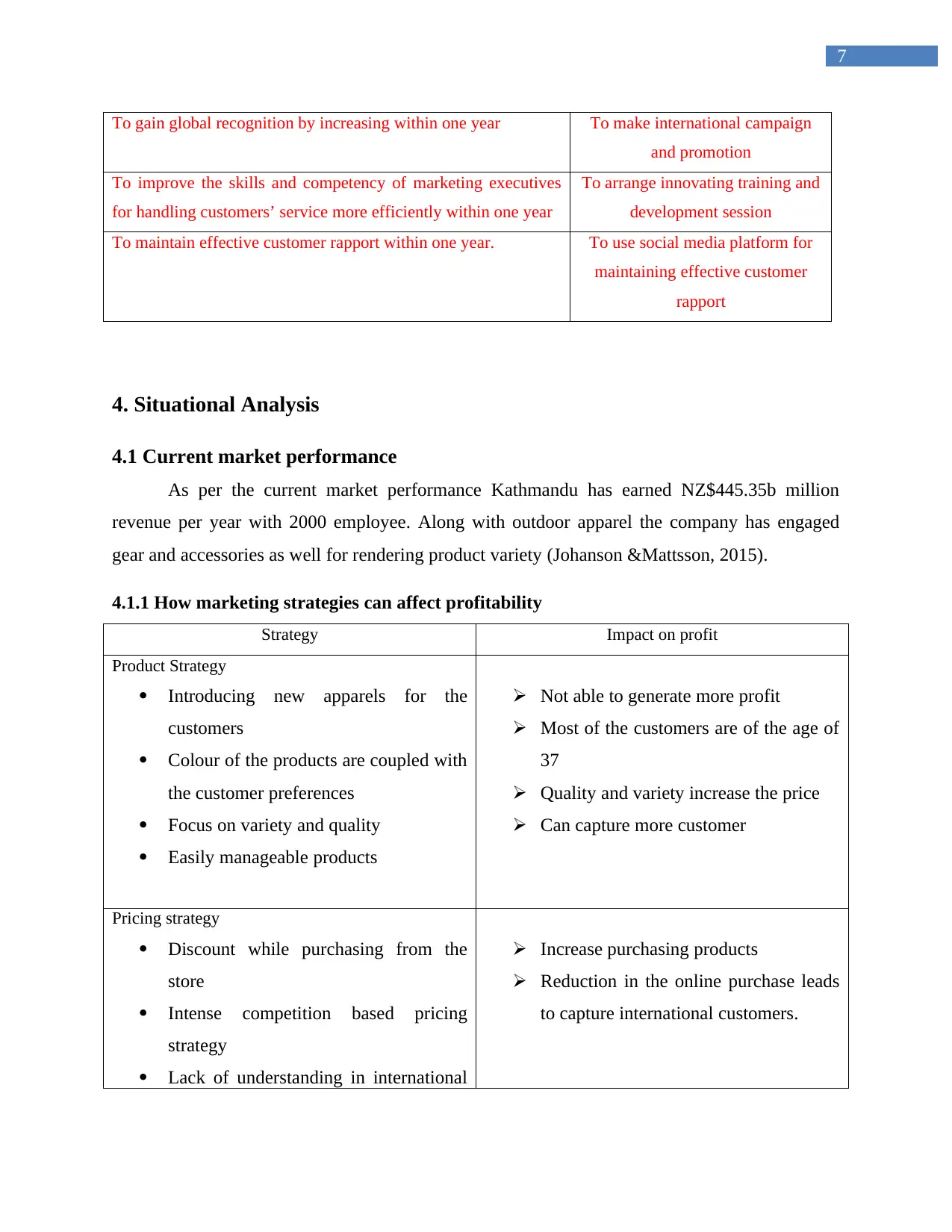
7
To gain global recognition by increasing within one year To make international campaign
and promotion
To improve the skills and competency of marketing executives
for handling customers’ service more efficiently within one year
To arrange innovating training and
development session
To maintain effective customer rapport within one year. To use social media platform for
maintaining effective customer
rapport
4. Situational Analysis
4.1 Current market performance
As per the current market performance Kathmandu has earned NZ$445.35b million
revenue per year with 2000 employee. Along with outdoor apparel the company has engaged
gear and accessories as well for rendering product variety (Johanson &Mattsson, 2015).
4.1.1 How marketing strategies can affect profitability
Strategy Impact on profit
Product Strategy
Introducing new apparels for the
customers
Colour of the products are coupled with
the customer preferences
Focus on variety and quality
Easily manageable products
Not able to generate more profit
Most of the customers are of the age of
37
Quality and variety increase the price
Can capture more customer
Pricing strategy
Discount while purchasing from the
store
Intense competition based pricing
strategy
Lack of understanding in international
Increase purchasing products
Reduction in the online purchase leads
to capture international customers.
To gain global recognition by increasing within one year To make international campaign
and promotion
To improve the skills and competency of marketing executives
for handling customers’ service more efficiently within one year
To arrange innovating training and
development session
To maintain effective customer rapport within one year. To use social media platform for
maintaining effective customer
rapport
4. Situational Analysis
4.1 Current market performance
As per the current market performance Kathmandu has earned NZ$445.35b million
revenue per year with 2000 employee. Along with outdoor apparel the company has engaged
gear and accessories as well for rendering product variety (Johanson &Mattsson, 2015).
4.1.1 How marketing strategies can affect profitability
Strategy Impact on profit
Product Strategy
Introducing new apparels for the
customers
Colour of the products are coupled with
the customer preferences
Focus on variety and quality
Easily manageable products
Not able to generate more profit
Most of the customers are of the age of
37
Quality and variety increase the price
Can capture more customer
Pricing strategy
Discount while purchasing from the
store
Intense competition based pricing
strategy
Lack of understanding in international
Increase purchasing products
Reduction in the online purchase leads
to capture international customers.
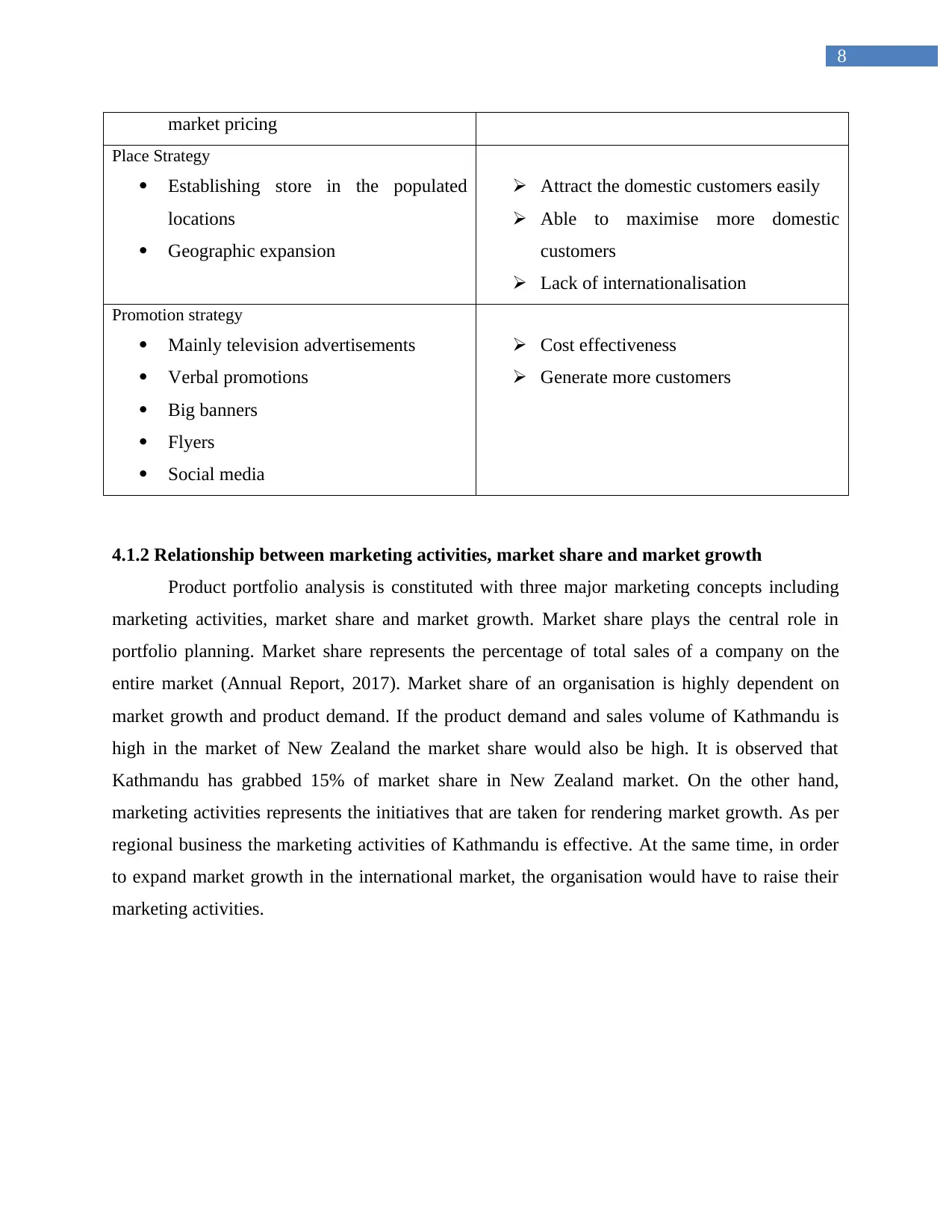
8
market pricing
Place Strategy
Establishing store in the populated
locations
Geographic expansion
Attract the domestic customers easily
Able to maximise more domestic
customers
Lack of internationalisation
Promotion strategy
Mainly television advertisements
Verbal promotions
Big banners
Flyers
Social media
Cost effectiveness
Generate more customers
4.1.2 Relationship between marketing activities, market share and market growth
Product portfolio analysis is constituted with three major marketing concepts including
marketing activities, market share and market growth. Market share plays the central role in
portfolio planning. Market share represents the percentage of total sales of a company on the
entire market (Annual Report, 2017). Market share of an organisation is highly dependent on
market growth and product demand. If the product demand and sales volume of Kathmandu is
high in the market of New Zealand the market share would also be high. It is observed that
Kathmandu has grabbed 15% of market share in New Zealand market. On the other hand,
marketing activities represents the initiatives that are taken for rendering market growth. As per
regional business the marketing activities of Kathmandu is effective. At the same time, in order
to expand market growth in the international market, the organisation would have to raise their
marketing activities.
market pricing
Place Strategy
Establishing store in the populated
locations
Geographic expansion
Attract the domestic customers easily
Able to maximise more domestic
customers
Lack of internationalisation
Promotion strategy
Mainly television advertisements
Verbal promotions
Big banners
Flyers
Social media
Cost effectiveness
Generate more customers
4.1.2 Relationship between marketing activities, market share and market growth
Product portfolio analysis is constituted with three major marketing concepts including
marketing activities, market share and market growth. Market share plays the central role in
portfolio planning. Market share represents the percentage of total sales of a company on the
entire market (Annual Report, 2017). Market share of an organisation is highly dependent on
market growth and product demand. If the product demand and sales volume of Kathmandu is
high in the market of New Zealand the market share would also be high. It is observed that
Kathmandu has grabbed 15% of market share in New Zealand market. On the other hand,
marketing activities represents the initiatives that are taken for rendering market growth. As per
regional business the marketing activities of Kathmandu is effective. At the same time, in order
to expand market growth in the international market, the organisation would have to raise their
marketing activities.
⊘ This is a preview!⊘
Do you want full access?
Subscribe today to unlock all pages.

Trusted by 1+ million students worldwide
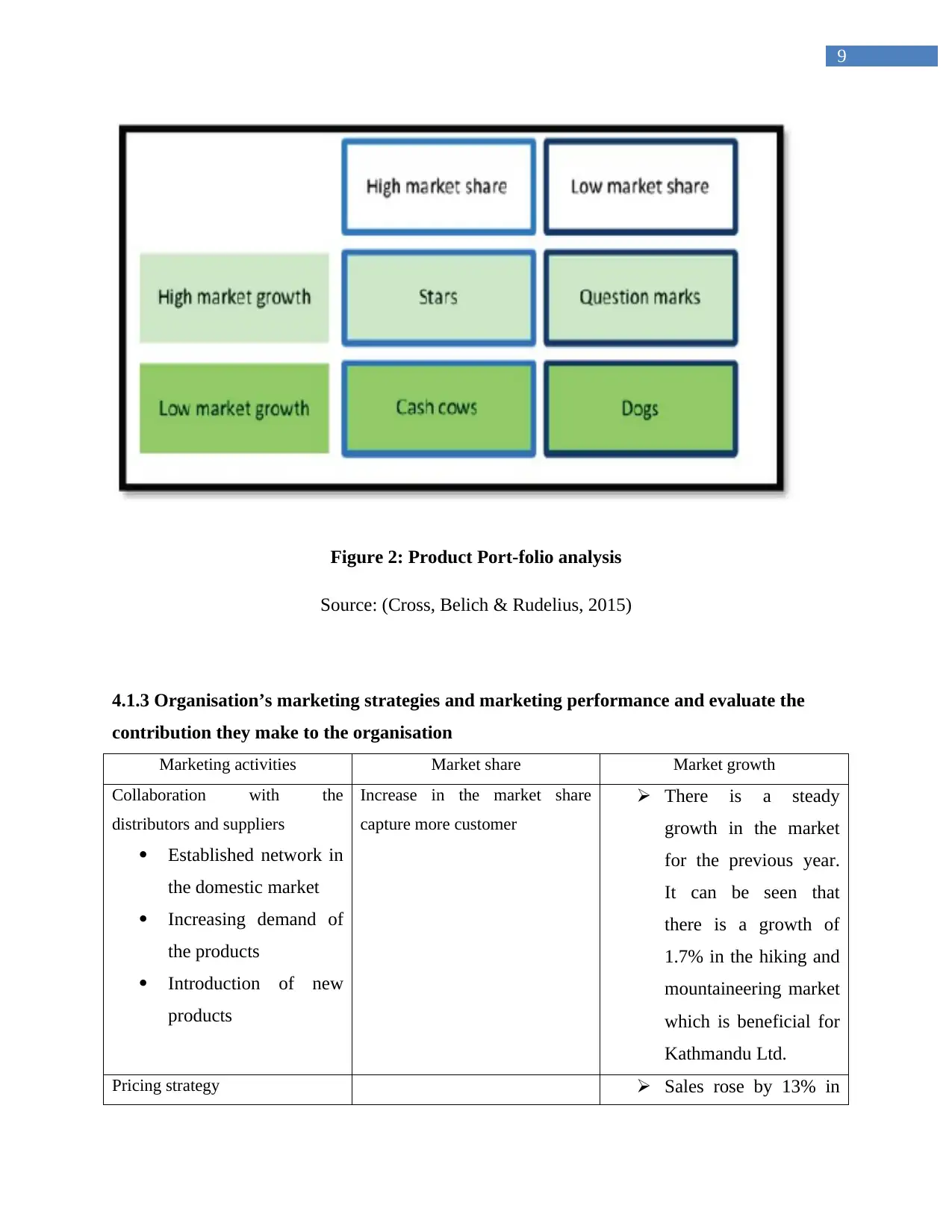
9
Figure 2: Product Port-folio analysis
Source: (Cross, Belich & Rudelius, 2015)
4.1.3 Organisation’s marketing strategies and marketing performance and evaluate the
contribution they make to the organisation
Marketing activities Market share Market growth
Collaboration with the
distributors and suppliers
Established network in
the domestic market
Increasing demand of
the products
Introduction of new
products
Increase in the market share
capture more customer
There is a steady
growth in the market
for the previous year.
It can be seen that
there is a growth of
1.7% in the hiking and
mountaineering market
which is beneficial for
Kathmandu Ltd.
Pricing strategy Sales rose by 13% in
Figure 2: Product Port-folio analysis
Source: (Cross, Belich & Rudelius, 2015)
4.1.3 Organisation’s marketing strategies and marketing performance and evaluate the
contribution they make to the organisation
Marketing activities Market share Market growth
Collaboration with the
distributors and suppliers
Established network in
the domestic market
Increasing demand of
the products
Introduction of new
products
Increase in the market share
capture more customer
There is a steady
growth in the market
for the previous year.
It can be seen that
there is a growth of
1.7% in the hiking and
mountaineering market
which is beneficial for
Kathmandu Ltd.
Pricing strategy Sales rose by 13% in
Paraphrase This Document
Need a fresh take? Get an instant paraphrase of this document with our AI Paraphraser
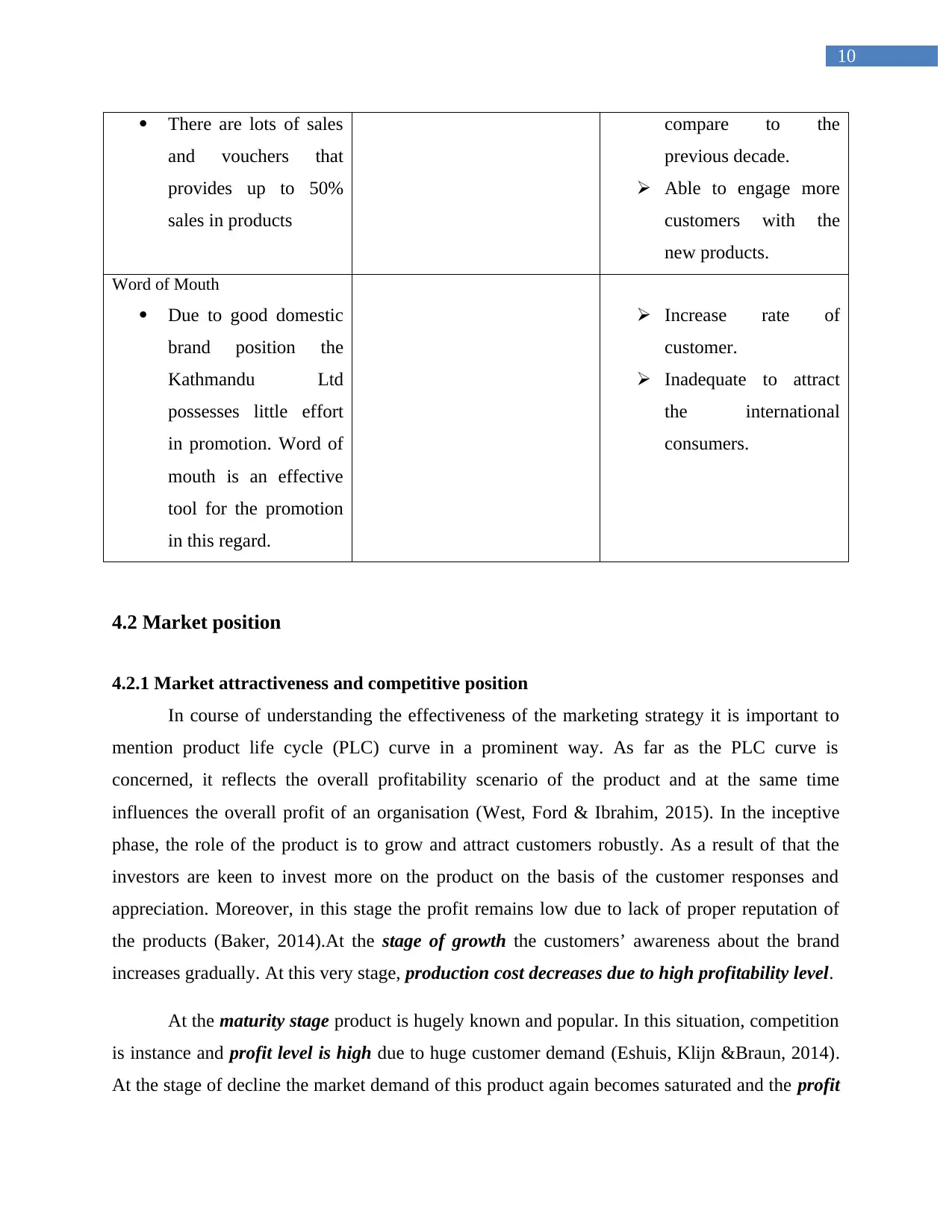
10
There are lots of sales
and vouchers that
provides up to 50%
sales in products
compare to the
previous decade.
Able to engage more
customers with the
new products.
Word of Mouth
Due to good domestic
brand position the
Kathmandu Ltd
possesses little effort
in promotion. Word of
mouth is an effective
tool for the promotion
in this regard.
Increase rate of
customer.
Inadequate to attract
the international
consumers.
4.2 Market position
4.2.1 Market attractiveness and competitive position
In course of understanding the effectiveness of the marketing strategy it is important to
mention product life cycle (PLC) curve in a prominent way. As far as the PLC curve is
concerned, it reflects the overall profitability scenario of the product and at the same time
influences the overall profit of an organisation (West, Ford & Ibrahim, 2015). In the inceptive
phase, the role of the product is to grow and attract customers robustly. As a result of that the
investors are keen to invest more on the product on the basis of the customer responses and
appreciation. Moreover, in this stage the profit remains low due to lack of proper reputation of
the products (Baker, 2014).At the stage of growth the customers’ awareness about the brand
increases gradually. At this very stage, production cost decreases due to high profitability level.
At the maturity stage product is hugely known and popular. In this situation, competition
is instance and profit level is high due to huge customer demand (Eshuis, Klijn &Braun, 2014).
At the stage of decline the market demand of this product again becomes saturated and the profit
There are lots of sales
and vouchers that
provides up to 50%
sales in products
compare to the
previous decade.
Able to engage more
customers with the
new products.
Word of Mouth
Due to good domestic
brand position the
Kathmandu Ltd
possesses little effort
in promotion. Word of
mouth is an effective
tool for the promotion
in this regard.
Increase rate of
customer.
Inadequate to attract
the international
consumers.
4.2 Market position
4.2.1 Market attractiveness and competitive position
In course of understanding the effectiveness of the marketing strategy it is important to
mention product life cycle (PLC) curve in a prominent way. As far as the PLC curve is
concerned, it reflects the overall profitability scenario of the product and at the same time
influences the overall profit of an organisation (West, Ford & Ibrahim, 2015). In the inceptive
phase, the role of the product is to grow and attract customers robustly. As a result of that the
investors are keen to invest more on the product on the basis of the customer responses and
appreciation. Moreover, in this stage the profit remains low due to lack of proper reputation of
the products (Baker, 2014).At the stage of growth the customers’ awareness about the brand
increases gradually. At this very stage, production cost decreases due to high profitability level.
At the maturity stage product is hugely known and popular. In this situation, competition
is instance and profit level is high due to huge customer demand (Eshuis, Klijn &Braun, 2014).
At the stage of decline the market demand of this product again becomes saturated and the profit
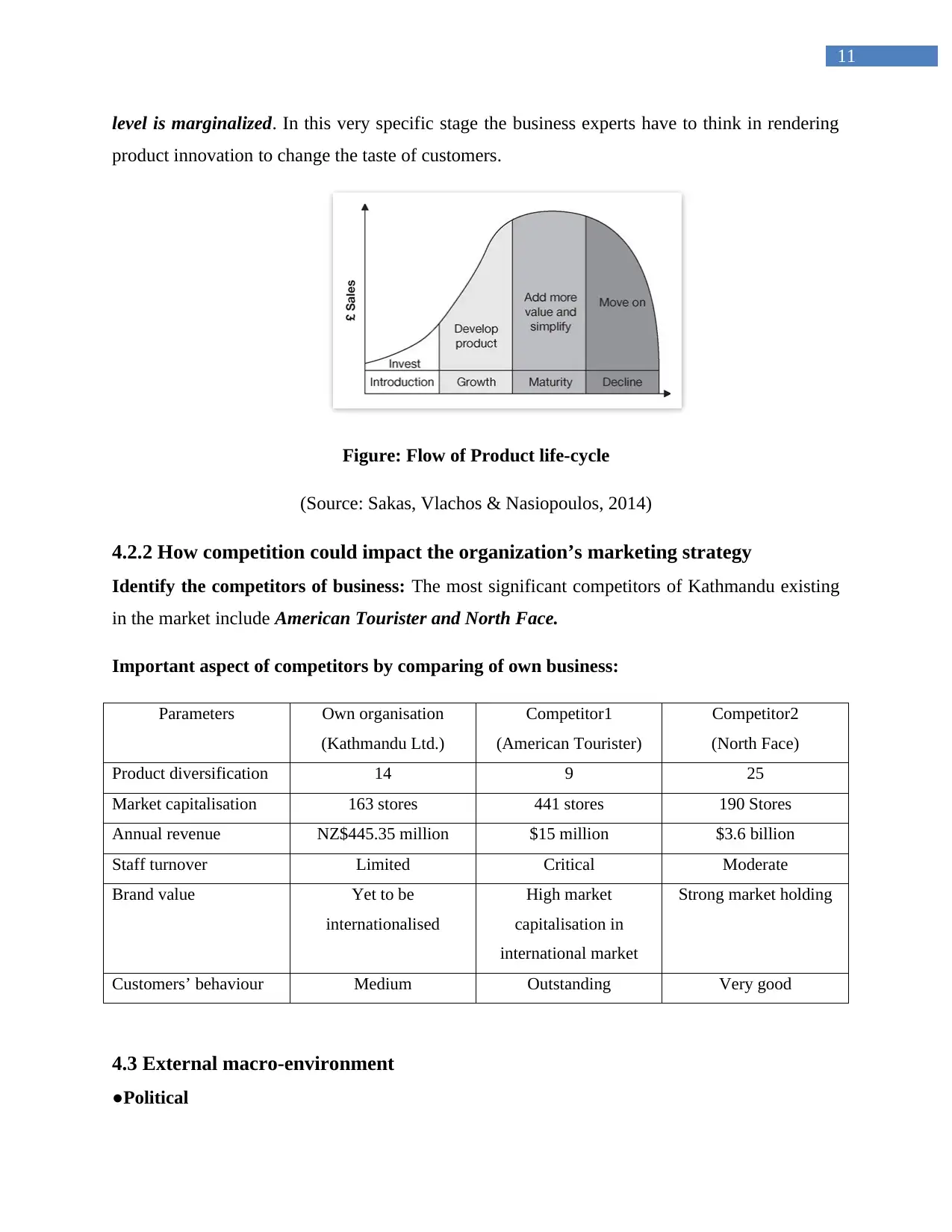
11
level is marginalized. In this very specific stage the business experts have to think in rendering
product innovation to change the taste of customers.
Figure: Flow of Product life-cycle
(Source: Sakas, Vlachos & Nasiopoulos, 2014)
4.2.2 How competition could impact the organization’s marketing strategy
Identify the competitors of business: The most significant competitors of Kathmandu existing
in the market include American Tourister and North Face.
Important aspect of competitors by comparing of own business:
Parameters Own organisation
(Kathmandu Ltd.)
Competitor1
(American Tourister)
Competitor2
(North Face)
Product diversification 14 9 25
Market capitalisation 163 stores 441 stores 190 Stores
Annual revenue NZ$445.35 million $15 million $3.6 billion
Staff turnover Limited Critical Moderate
Brand value Yet to be
internationalised
High market
capitalisation in
international market
Strong market holding
Customers’ behaviour Medium Outstanding Very good
4.3 External macro-environment
●Political
level is marginalized. In this very specific stage the business experts have to think in rendering
product innovation to change the taste of customers.
Figure: Flow of Product life-cycle
(Source: Sakas, Vlachos & Nasiopoulos, 2014)
4.2.2 How competition could impact the organization’s marketing strategy
Identify the competitors of business: The most significant competitors of Kathmandu existing
in the market include American Tourister and North Face.
Important aspect of competitors by comparing of own business:
Parameters Own organisation
(Kathmandu Ltd.)
Competitor1
(American Tourister)
Competitor2
(North Face)
Product diversification 14 9 25
Market capitalisation 163 stores 441 stores 190 Stores
Annual revenue NZ$445.35 million $15 million $3.6 billion
Staff turnover Limited Critical Moderate
Brand value Yet to be
internationalised
High market
capitalisation in
international market
Strong market holding
Customers’ behaviour Medium Outstanding Very good
4.3 External macro-environment
●Political
⊘ This is a preview!⊘
Do you want full access?
Subscribe today to unlock all pages.

Trusted by 1+ million students worldwide
1 out of 32
Related Documents
Your All-in-One AI-Powered Toolkit for Academic Success.
+13062052269
info@desklib.com
Available 24*7 on WhatsApp / Email
![[object Object]](/_next/static/media/star-bottom.7253800d.svg)
Unlock your academic potential
Copyright © 2020–2025 A2Z Services. All Rights Reserved. Developed and managed by ZUCOL.





